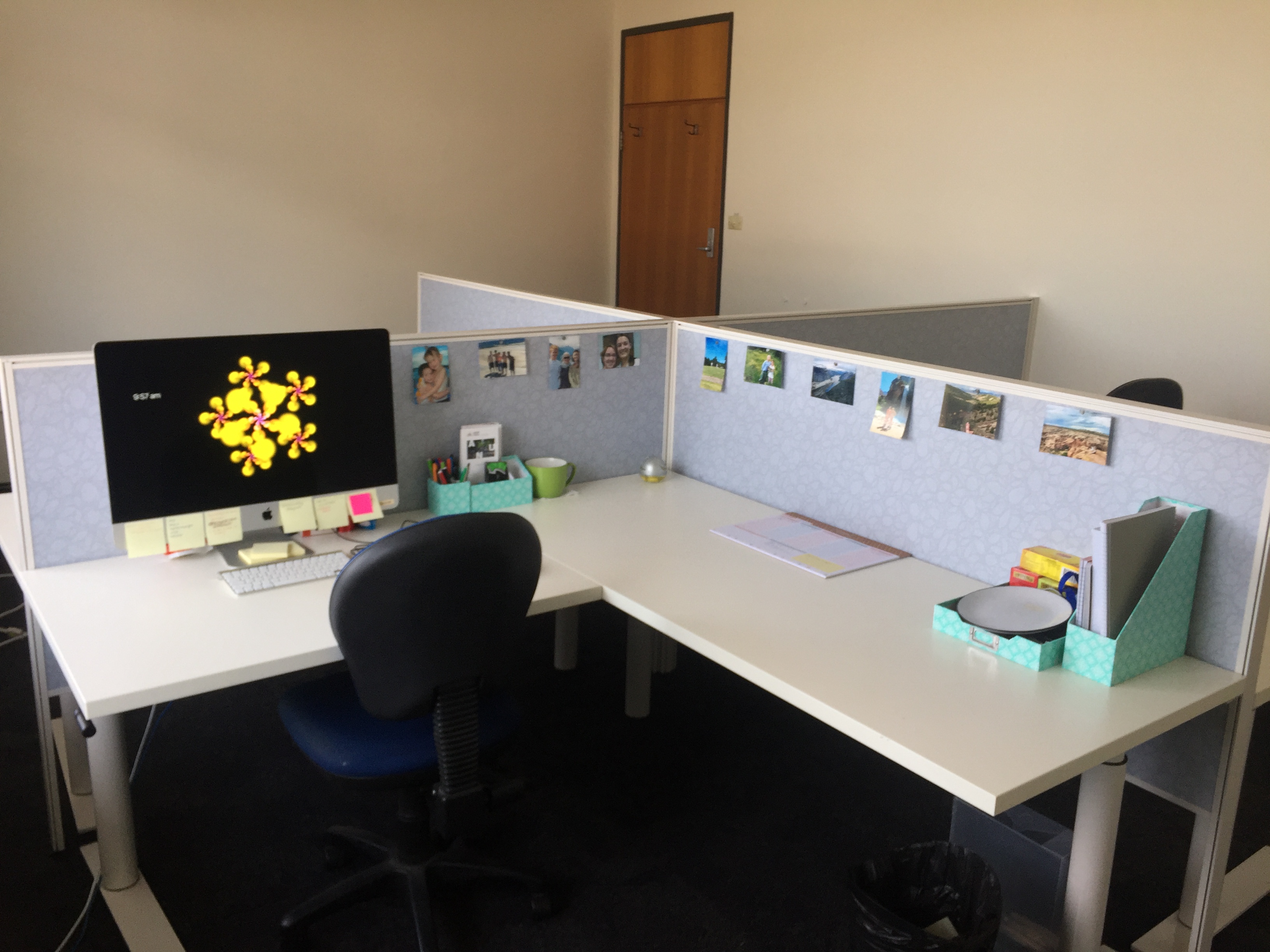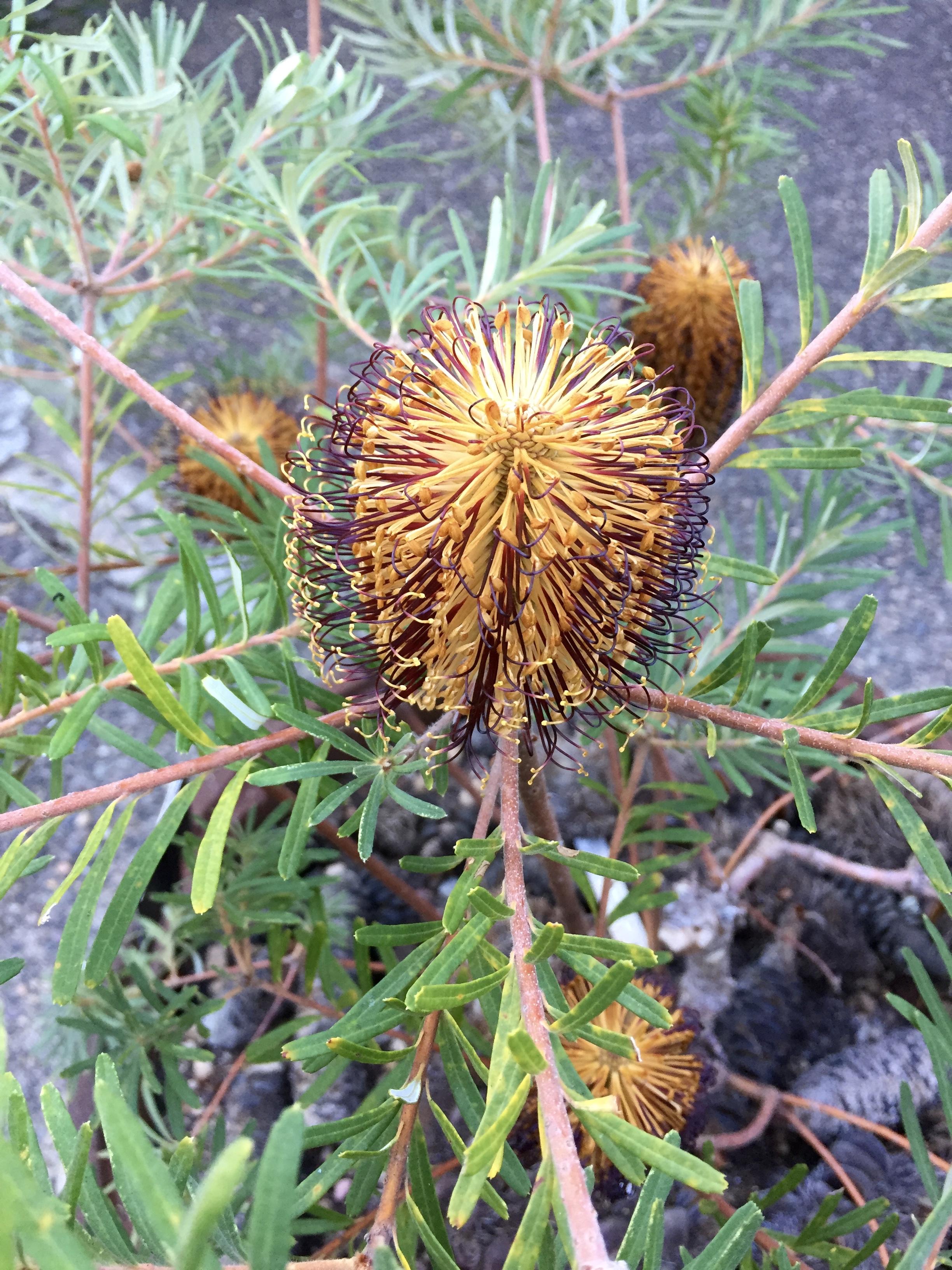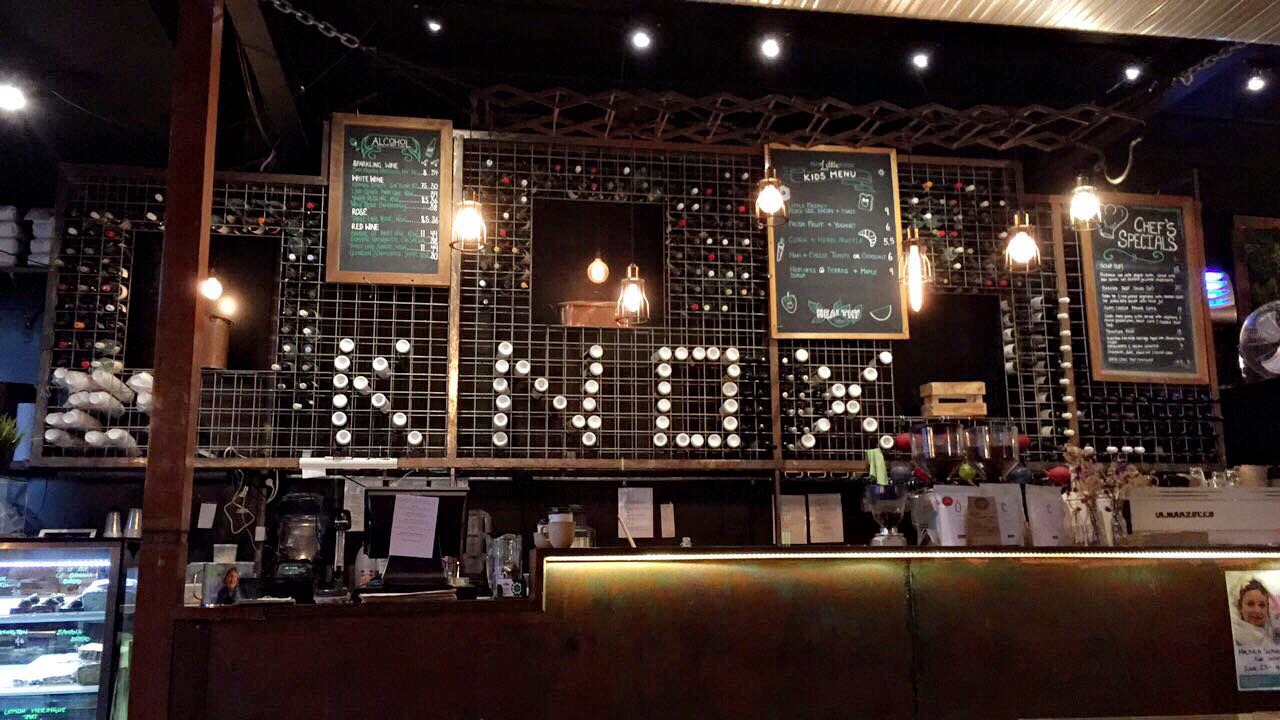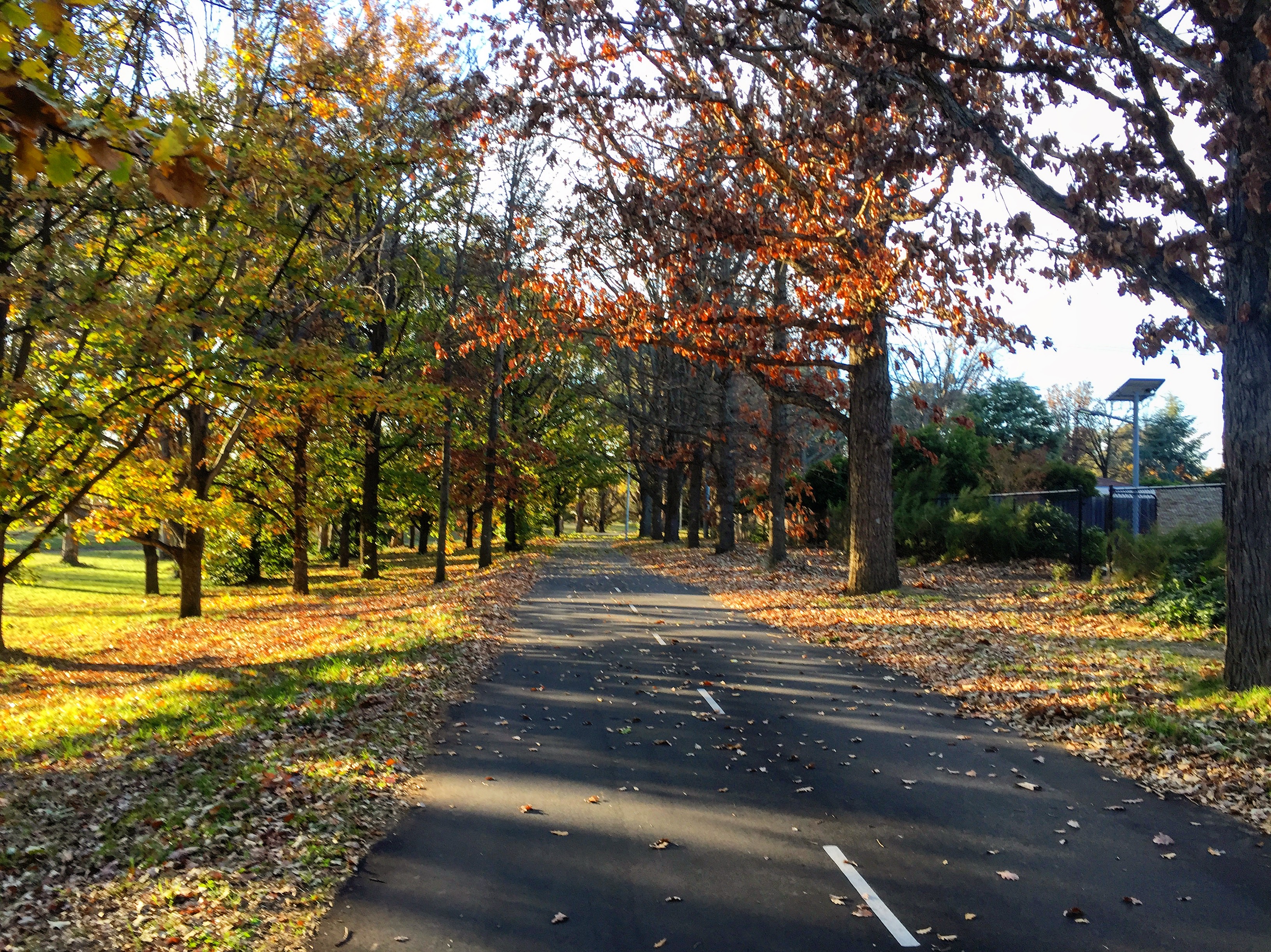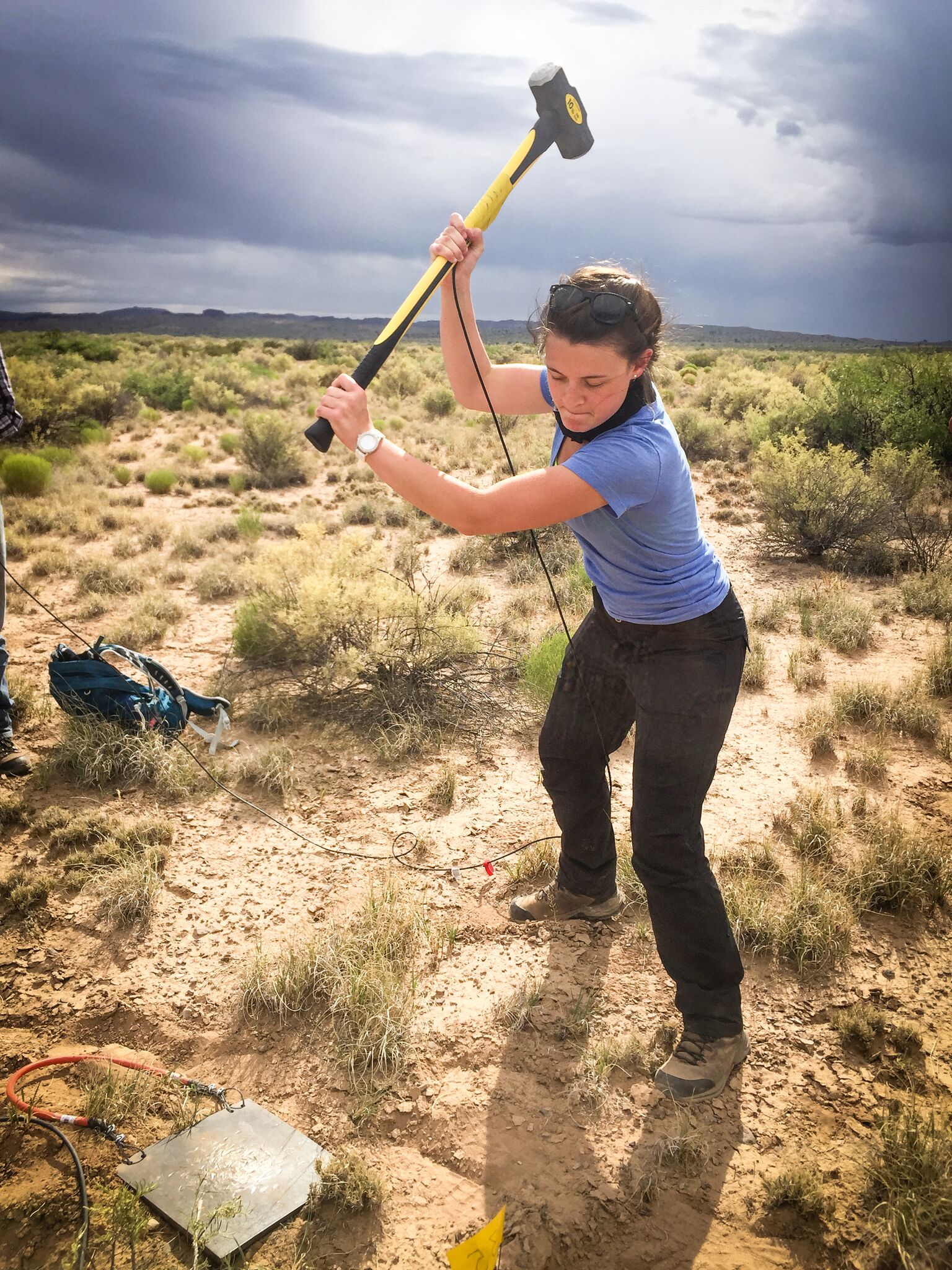Claire Richardson
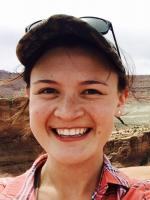
Claire Richardson is a student at University of Nebraska-Lincoln currently completing her research at The Australian National University under Dr. Hrvoje Tkalčić.
This summer, I will be working with a research group at the Australian National University using ScS-S travel times to image the core-mantle boundary (CMB), using a Bayesian framework and data recorded in Australia. The aim of this project is to characterize heterogeneities in the lowermost layer of the mantle, which includes partial melting, anisotropy, and thermal and chemical heterogeneities.
A ride on the GMT struggle bus
July 10th, 2017
It’s been a busy couple of weeks since I last posted an update! Luckily, in this case busy=productive, so there is plenty to write about.
Before I dive into more of the project, here's a photo of my work space to get you in the right headspace:
During my fourth week, GMT (that’s Generic Mapping Tool, for the folks back home) and I spent a lot of time together. Since I was new to the program, I just used simple C shell scripts to map all of the Australian seismic stations that were active between 1990 and 2016, and then made individual maps for each year’s deployments. The time consuming part about this was not writing the scripts (after the first one I pretty much just had to change the input file variable to the next year’s text file of stations), but having to sort through 26 years of deployments. This would have been a snap had the date of the deployment been entered in three separate columns—one for day, one for month, one for year. I could have just sorted the data by the “year” column, and voiala! However, since the deployment date was entered as one line (dd/mm/yyyy) instead of being separated into three different columns, I just used the “awk” command to search by “yyyy” (for example, “awk ‘/2005/’ stations.txt” would give me all of the lines of data in the file of all of the stations (stations.txt) that had the numbers 2-0-0-5 written together consecutively. While this made things a little easier, it also displayed stations that were removed in 2005, along with other miscellaneous lines of data that coincidentally had 2-0-0-5 written in them somewhere. Wading through this data took me a while, but eventually I got everything sorted, separated, and mapped. I’m sure that there was an easier, much more efficient way to have done that, but my Linux skills were/are still pretty rudimentary. That being said, I’m happy to report that I’m improving with practice!
I spent much of week five grappling with the next big challenge, which proved itself to be the biggest yet of this project—deciding which data to use. Since this is a relatively small project, I don’t have time to hand pick the (at least) tens of thousands of earthquakes that have occurred around Australia since 1990, nor would I want to. Not only would that be staggeringly tedious, but the seismic phase that I need to see (ScS) is only clear in a seismogram under certain conditions:
1. The event and the seismometer must be ~40-80º from each other (this is called the epicentral distance). This is necessary because at these distances there will be minimal interference between ScS and other phases.
2. The event must be deep enough to bypass crustal heterogeneities (I looked for events deeper than 200 km).
3. The event must be big enough to produce waves that can reach the core-mantle boundary (ScS waves are waves that propagate all the way through the mantle and bounce off of the outer core).
Throw into the mix that Australia is ~40º across, and that the stations I’m working with were deployed in concentrations in different geographic locations in different years (for example, some years Tasmania was heavily covered, and others it had no sensors at all), and I was looking at quite a bit of strategizing to choose the best possible events. Eventually, I was able to come up with a list of 15 events that are (fingers crossed) perfect candidates for ScS phases, and that will give a decent ray path coverage around the continent.
About halfway through last week, I was given two assignments. One was to prepare a write up of this project that will eventually become my AGU abstract. While the deadline isn’t for another few weeks (heads up for any of you who haven’t thought about it for a little while), I’m glad to have the first “draft” done. What I have now is only a little more than half a page, but it took me a good chunk of the weekend to write. That being said, I feel really good about it so far. I found myself harkening back to both the elevator speech assignment from a couple of weeks ago, as well as the project description that I was initially given when picking which projects I was interested in for the summer.
The purpose of my other assignment was to put my new GMT skills to the test. I had to map my stations and events, and the great circle paths that connect them to each other. I was able to get the stations and events on one map, but I’m still working on the paths. Thankfully, I’ve at least got a script that’s already been written for it, and I just have to figure out what all of the commands are doing. This is what I have so far:
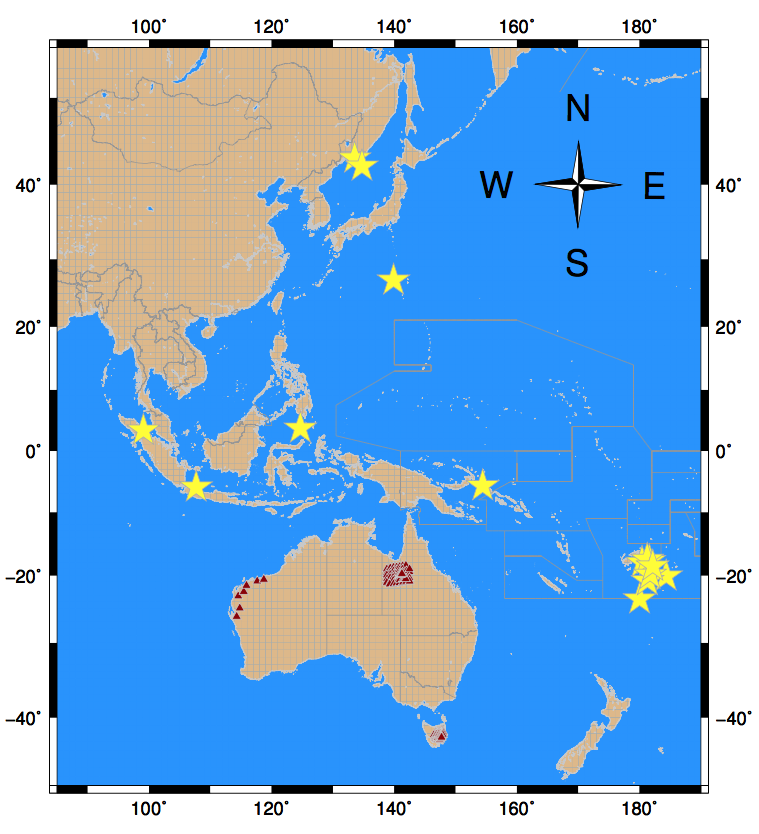
It's not perfect-I've still got my work cut out for me-but it's a good start.
In other news, I visited Canberra’s botanical gardens a little over a week ago, and it was incredible. A decent amount of the vegetation here is drastically different from back home, so it’s really cool to be able to see it all—or at least, try to see it all—in one place. I’m planning to go back this weekend, and hike all the way up to Telstra tower at the top of Black Mountain (don’t be fooled, it’s one of those glorified hills), which is one of Canberra’s iconic landmarks. Here are some photos from the gardens:
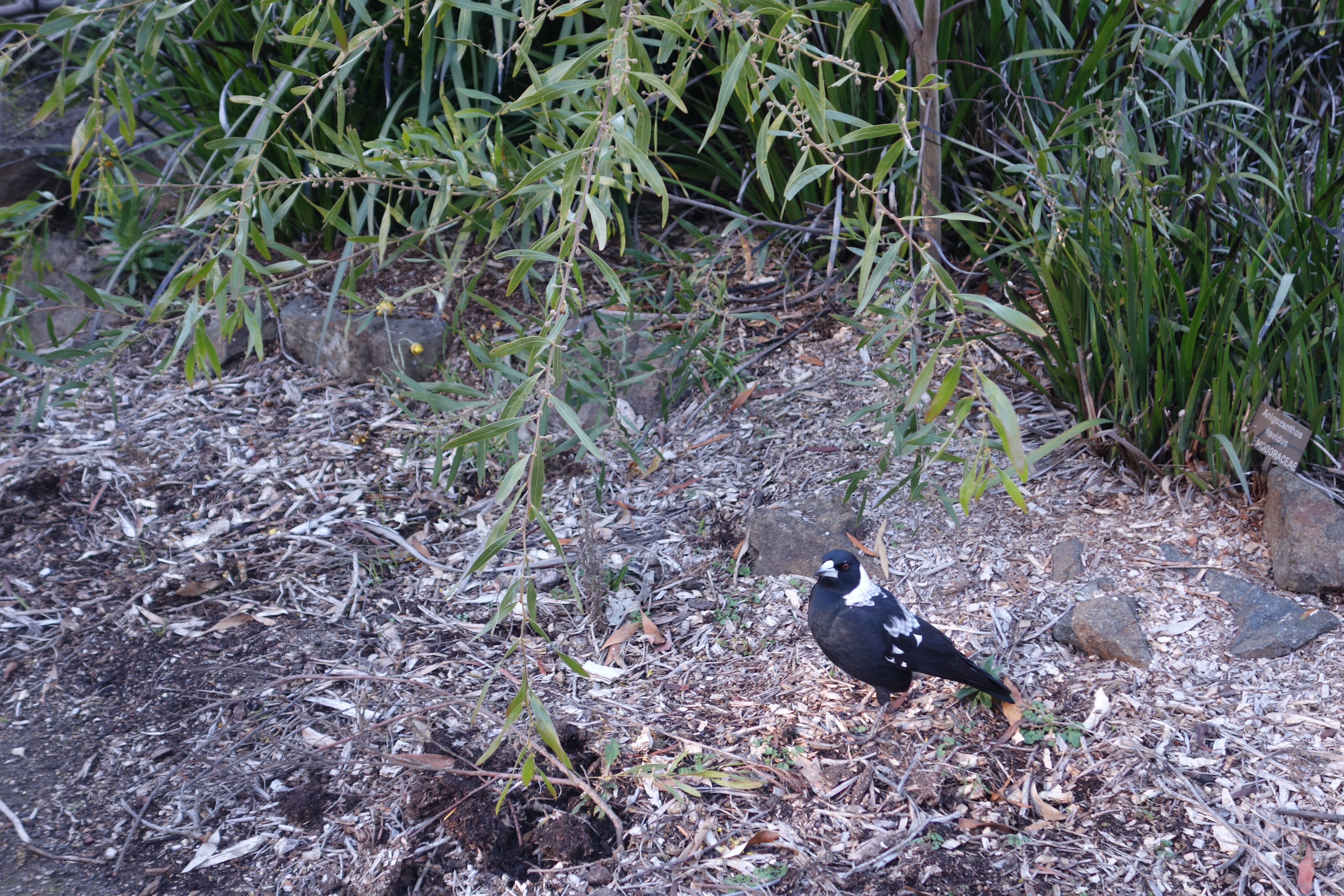
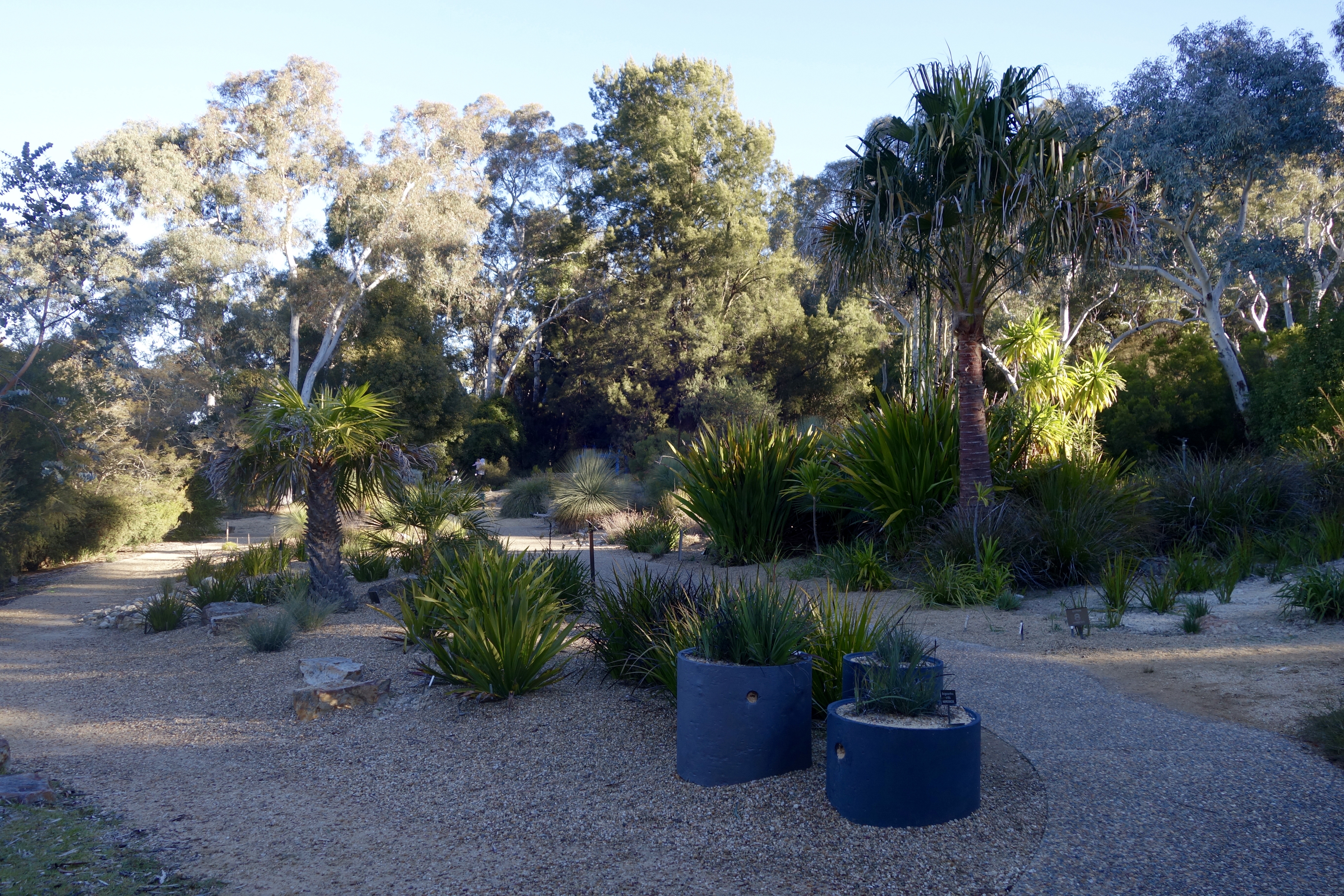
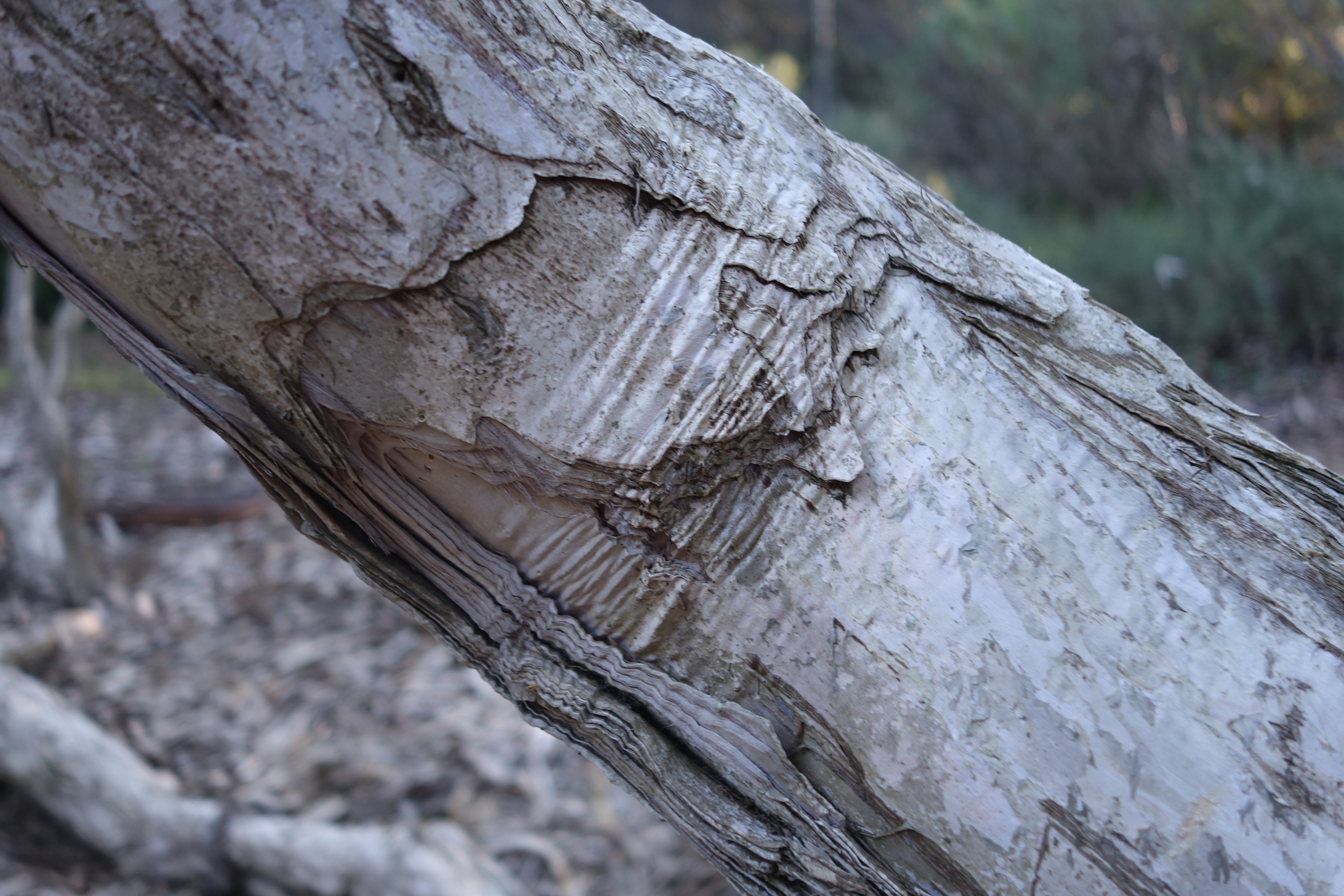
One of the traditions here at RSES is cake Friday, which is just the regular 10:30 morning tea, except one of the students also bakes a cake to share with everyone. The catch is that whoever bakes the cake has to use two ingredients that are chosen by pulling from a bunch of slips of paper in a mug. These ingredients can be pretty unorthodox (for example, last week was peanut butter and Donald Trump). Last time I was given the honor of being chosen to bake for this week’s cake Friday, with the ingredients “sour cream” and “lava”, and I’ve got some pretty nerdy geology/volcanology ideas for these geophysicists.
In between working on my abstract this weekend, I was able to have a bit of fun. On Saturday I booked a trip to Melbourne for the weekend of the 22nd and 23rd, and on Sunday I met one of the friends I've made for supper in the city.
I think that just about does it! Cheers!
Science in sixty seconds
June 26th, 2017
Well folks, I've survived another week in the land famoulsy known for harboring everything that wants to kill you.


This week was pretty lowkey in the office. I've been working a lot on getting to know and love GMT and SAC which I will continue this week, as well as learning to navigate the shared computers here remotely from my desktop. It will be from these computers that I will access the data that I need, as they have far more computing power than my iMac and they hold all of the data collected from the Australian seismic stations. Hrvoje will be returning later this week, so I will really be able to start getting my hands dirty with this project soon. On Friday, I attended the first meeting of the research group, where Nita, one of the PhD students, presented her work. I'm happy to report that I understood a good deal of it, but I mostly attribute that to my geology background. Some of the geophysics is still out of reach, but I've already learned a great deal and am confident that I'm going to leave here in August with a wealth of geophysical knowledge. I'm also getting to know the people in the research group, which is making for a comfortable atmosphere that makes me feel like I can ask questions and seek guidance when I need it (which is often).
The weekly assignment from IRIS was to prepare an "elevator speech" to describe our (the interns) research in ~60 seconds, in terms that can be understood by those who don't have a scientific background. I started this assingment confidently, as I've had experience presenting my research in the past for such an audience at UNL's undergraduate research poster session. However, soon after I began I remembered how long it took me to get all of the information that had been on that poster down to just five minutes (shoutout to my advisor, Dr. Burberry, for dealing with me trying to do that), and I realized that this project was going to take more than the five or ten minutes I'd initially anticipated. From reading my collegues' blogs, it sounds like they had similar realizations. Thankfully I did four years of speech in high school, and since each year my pieces were way too long I have experience cutting out extra, non-vital information (another shoutout to my speech coach, Mrs. Jobman, for putting up with my insistance that everything was important). After about three hours, I'd come up with 147 words that I think sum up my project clearly and completely, and can be understood by a range of audiences. While practicing it out loud, I made tweaks for different potential audiences, ranging from people with no scientific background to people who I will be working with in this department. This is the finished product:
"It is generally accepted that the lowermost layer of the mantle—known as D’’—contains a fair amount of heterogeneity, such as pockets of partially melted rock, chunks of subducted crust, and spatially variable chemical properties. Basically, this layer is analogous to a chicken caesar salad, in that it has all sorts of different components that are a combination of liquid, solid, hot, and cold. Because of its extensively variable properties, D’’ is partially responsible for Earth’s magnetic field and plate tectonics, and in fact it is believed to be even more geologically complex than the crust. Since this layer is so deep within the earth it has proven difficult to image, and therefore my work will be to employ an innovative technique called Hierarchal Bayesian Inversion, which offers much higher resolution than those previously used, to characterize some of these heterogeneities using data collected in Australia."
This project and my poster presentation at UNL have both demonstrated the necessity of being able to communicate scientific research in a clear, succinct, and understandable way. This will be a useful skill not only for AGU in December and for conferences and poster sessions in the future, but also for everyday conversations. I have already found myself struggling to come up with a good answer when people ask me what research I'm doing while I'm here, whether they're friends from home who don't know what a body wave is, or grad students and professors here at ANU who make a living by researching this stuff. I certainly feel more prepared to answer that question after devoting some time to consolidating what my research is into a 60 second spiel.
My week outside of the office was equally as lowkey. As winter sets in, it's getting chillier here. The days have highs between 10 and 12ºC (low- to mid-50's) which are really pleasant when the sun is shining in the late morning and afternoon, but the nights reach and dip below freezing. I did my laundry yesterday afternoon and hung my clothes on the line to dry, and this morning when I went out the check on them they were frosty. I've become addicted to a hilarous Australian show that Ruby and Thusus introduced me to called Kath & Kim, which is about the antics of a mother and daughter living in suburban Melbourne, and have also been exposed to the classic Australian film "The Castle". In short, Australian humor is great. Other Australian things I've tried include Tim Tams, which are basically two chocolate buscuits stuck together with milk chocolate, and then all dipped in milk chocolate (they're wonderful), as well as Vegemite. Now, Vegemite has a bad rap with some people (for those who don't know what this savory, magical spread is, it's basically the leftover yeast sludge from beer making. Bear with me.) but that's only because they don't know how to eat it. You see, many people carelessly and barbarically slap it onto their toast like peanut butter--a spread that is best applied thick and lavishly--while it should be applied delicately, and with grace. A lightly toasted piece of multi-grain bread with a thin layer of butter and an equally thin layer of Vegemite, topped with avocado slices and a poached egg with a slightly runny yolk is literal perfection. I feel strongly about this. Fun Vegemite fact: Australians use this stuff like Americans use ketchup, and they actually sing the theme song in primary school choir.
Other than all that, I took the bike out on Saturday for a lovely ride around the lake in the center of town where several black swans were hanging out, and I've also officially started listening to podcasts! It's about time, too. People have been recommending "Welcome to Night Vale" to me literally for years, and I can happily report back that I love it.
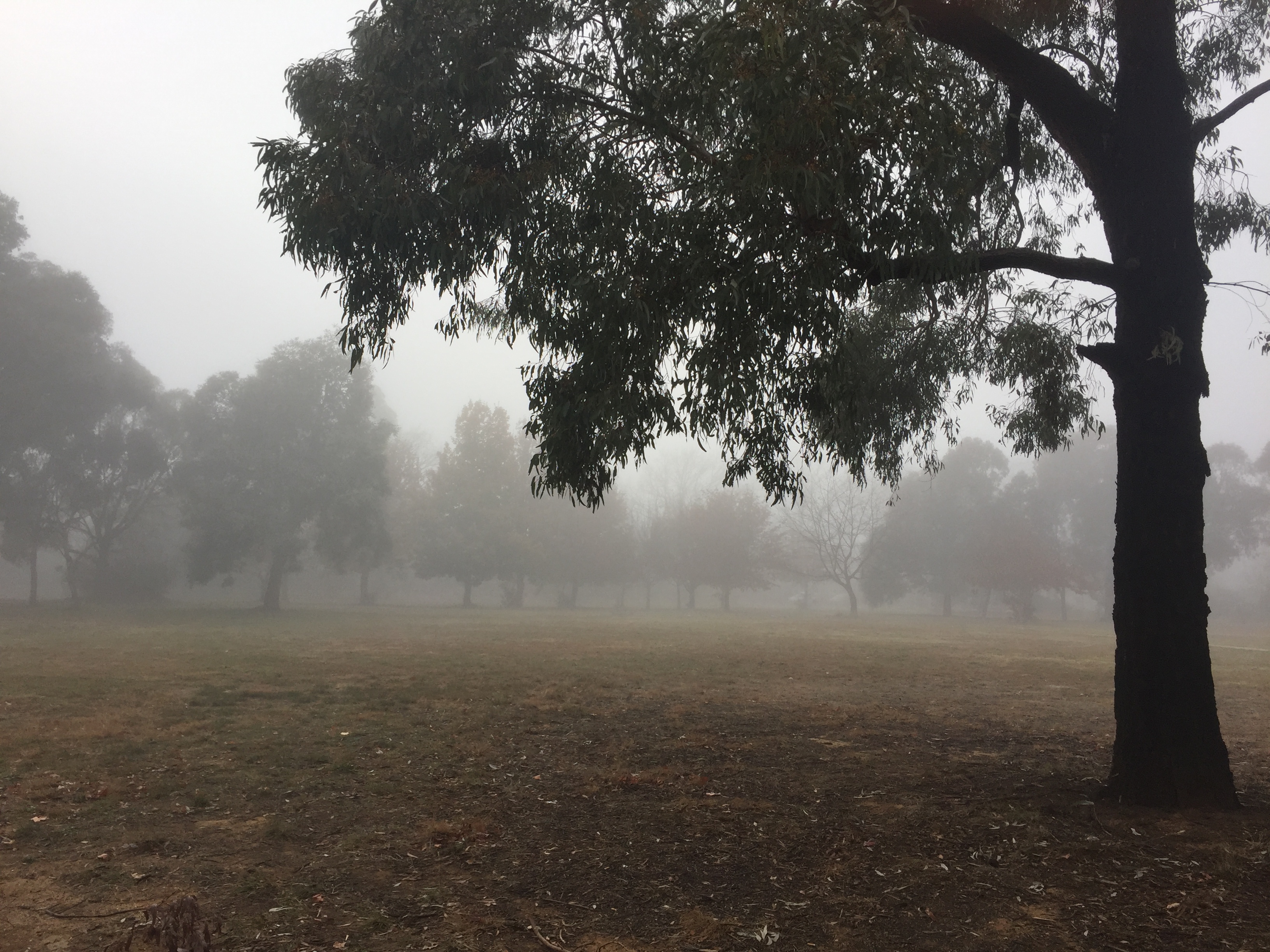

A chilly, foggy morning in the park where I wait for the bus to ANU, black swans on lake Burley Griffin during my bike ride on Saturday, and the inside of the Knox Made in Watson-the really lovely little coffee shop up the street from where I'm living.
That's all for this week! Ciao!
They gave me a name tag, so I guess you could say things are gettin’ pretty serious
June 19th, 2017
Greetings from Canberra!
It's been a busy week and a half since my last post, as things here are moving right along. Today is the first day of my second week at ANU, but before I go into that, let me pick up where I left off on the 7th.
The purpose of my first week here was to acclimate to life in a foreign country, and to get over the nasty jet lag before beginning my work. While I wasn't sleeping or doing background reading for the following week, I was exploring the city and the surrouding area. Since I am a caffeine addict (AKA Earth scientist), one of my main to-do's was to check out the [hipster] coffee scene in town. Between my house and the city center ("Civic") there's a street called Lonsdale Street, along which resides a host of lovely little cafés. Stein and Wysession text in hand, I picked one called 80/20 and ordered a latte from a friendly barista named Bec who, after hearing I'd be here alone until August, gave me her phone number and invited me out for supper with some of her friends the next week. This was an especially lucky run in, as there aren't many opportunities to meet people my age here. Since the seasons are flipped, most of the undergraduates have left for their winter break and campus feels a little deserted.
I spent most of the weekend finishing up background reading either at the house or at a different coffee shop just up the street called The Knox Made in Watson (another excellent, very hipster café). Monday the 12th was the Queen's birthday which is a holiday here, so Ruby and Thusus took me to the nearby Tidbinbilla Nature Reserve to see some wildlife. The drive up was gorgeous in itself. It was my first real chance to see the landscape outside of the city, which is in that grey area between hilly and mountainous. Quick note: the vegetation here is wonderful--about 95% of the trees are eucalyptus of different varieties, which gives the air just a tinge of that bright, minty scent, and many of the rest are deciduous trees that are still clinging to their autumn colored leaves. My favorite of these are the weeping willows that have been planted all around the ANU campus, whose big, brawny trunks and spindly branches are dripping with feathery, vibrant yellow leaves. Anyway, back to Tidbinbilla. Before we even got onto the reserve, we spotted a group of grey kangaroos eating lunch in a clearing. A couple of them were lying down, propped up on one elbow and looking just as relaxed as could be, while the others were balancing on their tails while their wonderful little hands were busy picking grass. Once we arrived on the reserve we found a path through the forest, which took us by a couple of platypuses (In case you're wondering, yes I googled "platypus plural". Either 'platypuses' or simply 'platypus' is correct, or, if you want to get technical, the proper Greek plural is 'platypodes'. Thanks, Wikipedia.), some pelicans and brolgas, a bandicoot or two, more kangaroos, a group of rock wallabies, and, of course, koalas, which I am now convinced are the cuddliest, cutest animals alive. By the time we got back to the car it was almost the end of the day, so we caught the sunset from a valley lookout before driving home.
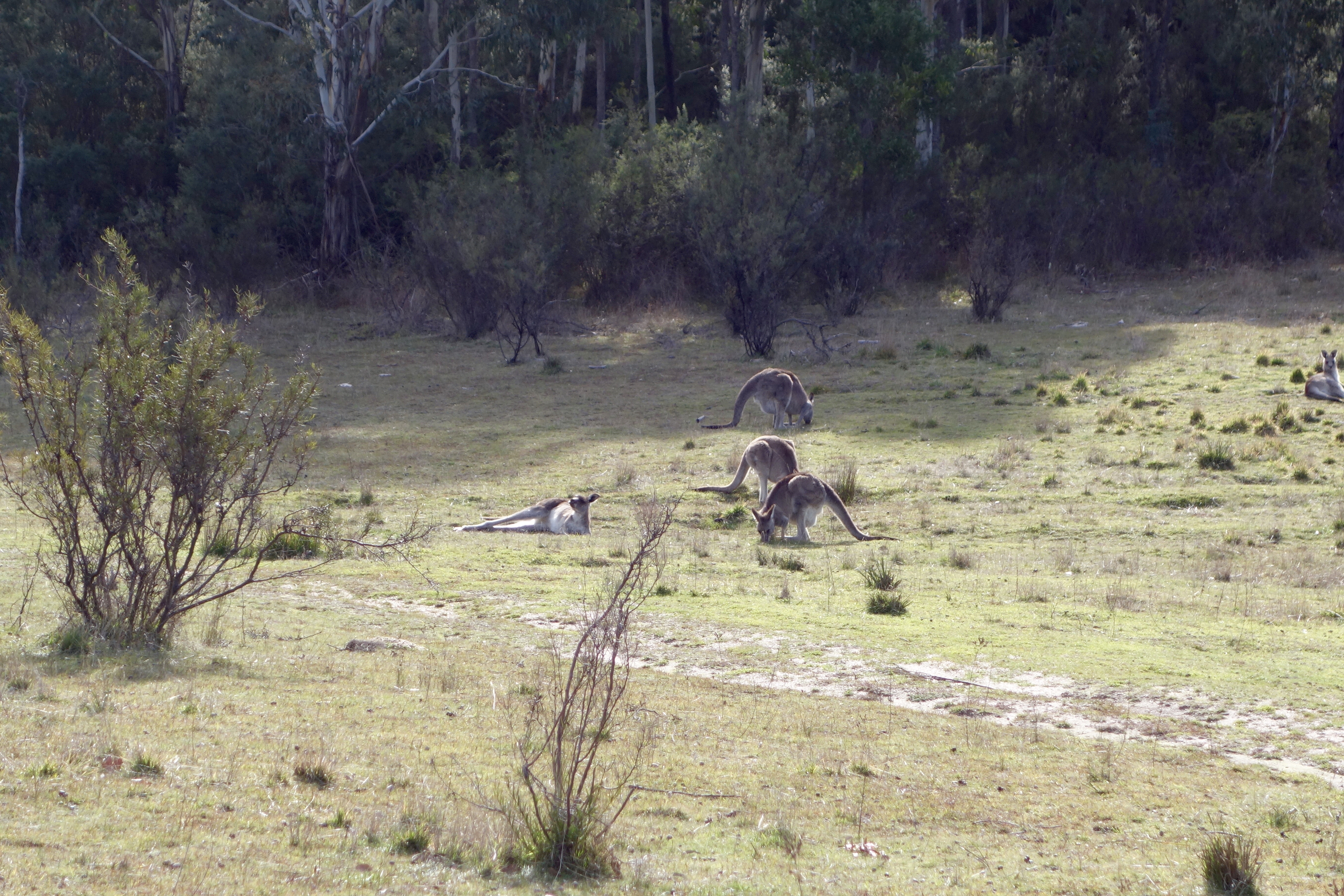
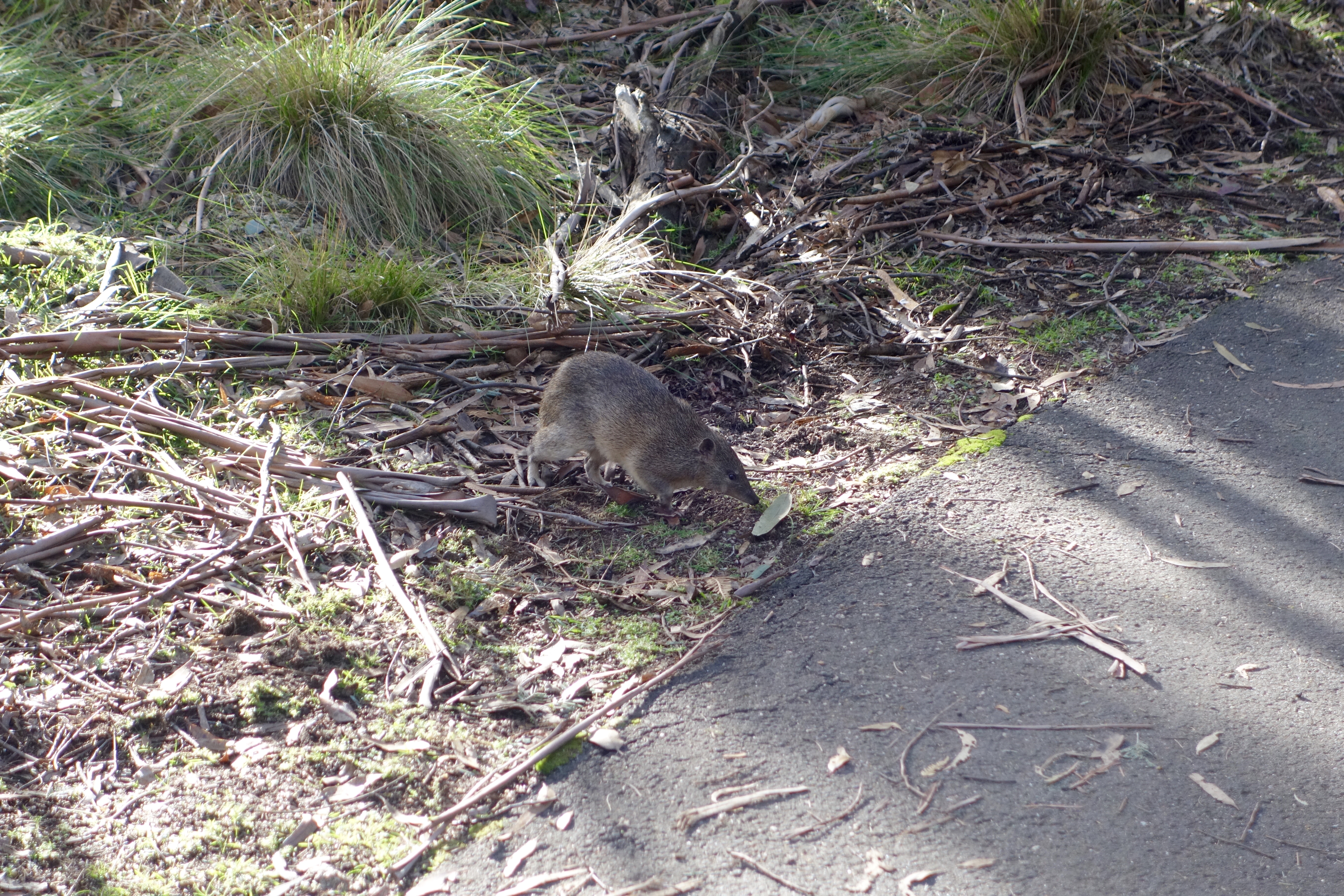
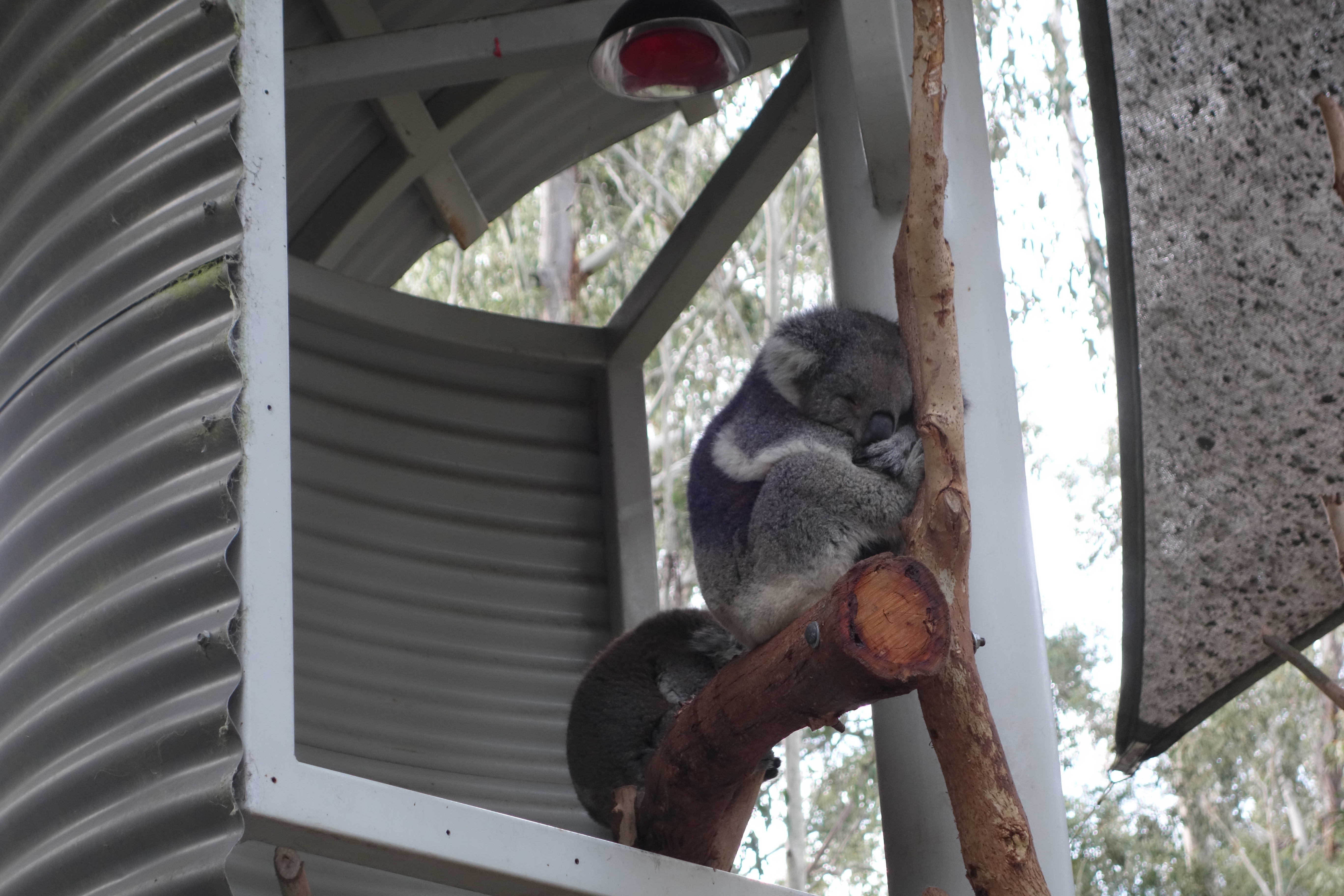

kangaroos, a friendly bandicoot, a sleepy koala, and a rock wallaby
The next day--Tuesday--was the first day of my first week at ANU. I met Sima, the postdoc who is helping me out until Hrvoje returns to ANU, outside of the main RSES building (Jaeger 8), and she brought me inside to show me the ropes. As first days always are, things were a little awkward with tons of introductions, but everyone was friendly and welcoming. To get in and out of most of the doors in the Jaeger complex you need a programmed swipe card which I wasn't able to get until today (Monday), so I had to use the one door in the complex that didn't require the card. Thankfully, that door is actually really conveniently located so it wasn't a big deal. I spent the rest of the week reading papers and working on tying up logistical loose ends at a desk in the office that Sima shares with Marija (another postdoc) and Zhi (a PhD student), and happily found that things here aren't on a rigorous schedule. This is especially good because I'm a bit of a night owl, and am not usually very productive right away in the morning (probably because I always stay up so late).
By the end of the week, after reading some papers, talking with Sima, and exchanging more emails with Hrvoje, I felt much more confident in my project. Essentially, we will be using ScS-S differential travel times to work out some of the heterogeneities in that mysterious D'' layer (the lowermost mantle). For those non-seismologist readers, S-waves are transverse waves that travel through the subsurface of the Earth, and that can't propagate through liquid. These waves are produced by a "source" (usually an earthquake), propagate through the crust and mantle of the Earth, and are recorded at a seismic station when they come back to the surface. ScS-waves are S-waves that propagate through the crust and the mantle and reflect off of the Core-Mantle Boundary (CMB), before being recorded at a seismic station. Basically, we'll be using the difference between the two travel times to make a model of the lowermost mantle--a layer that, in plain terms, is pretty funky. It is suspected that it is very heterogenous in most physical and chemical aspects--parts of it are molten, parts of it are anisotropic, some parts are much hotter than others, etc. etc. The running hypothesis is that it is a subducted slab "graveyard", where big chunks of crust that have been totally overriden by other tectonic plates have come to rest after sinking through the mantle. The idea of tomography is that, since seismic waves travel at different speeds through materials that have varying chemical and physical properties, we can work backwards from their arrival times and compare the actual travel time with the predicted travel time to say something about what those waves must have passed through. We'll be using what's called a Bayesian framework to gather data, which means that rather than using explicit model parameters, like blocks or spherical harmonics, which tend to lead to either too much seismic noise in the data or too little data in the data (Ha. By this I just mean that useful data gets thrown out because it's interpreted as seismic noise), we'll let our "grid" orient itself using voronoi polygons whose shape and orientation are driven by the available data. I realize I said "data" a lot in that sentence--sorry about that. Anyway, we'll be doing that for data collected at Australian stations, but will expand to global data if time permits. I haven't actually downloaded anything (trying to avoid using the d-word) yet, but will be starting in on that later this week.
After reading about and learning all of that, I was able to have a pretty nice weekend. I went out with Bec and her friends on Friday evening which, despite some initial social anxiety, was really quite nice. On Saturday I went to the farmer's market with Ruby and her sister Lily, where I had a wonderful homemade danish while Ruby bought fresh vegetables. Later that day I got the crazy idea that maybe I'd look better with short hair, so I walked to the nearest hair salon and got ~10 inches or hair cut off (woo, impulsivity! It turned out great, though, in case anyone was wondering). I spent all day Sunday walking around Canberra's parliamentary triangle with Marija, Zhi, and another graduate student here at RSES, and then watched Australian satire over half a pint of Ben and Jerry's when I got home.
All of that brings me to today. I've been all around Jaeger tying up the last of the loose ends, and now have my desk all set up, a desktop ready to go, my office key, my swipe card/name tag featuring the very official word "STAFF" under a wonderfully cheesy picture of me, and am all ready to start picking some data in the morning!
Before I sign off, a quick Canberra update: I adore this place. The quiet suburbs sprawl because everyone wants a back yard, and there are trees and parks and birds everywhere. At the close of each day, the sunset splashes its palette from horizon to horizon, and then sets it alight in a golden display of color. The magpies and cockatoos never stop singing. On some mornings, frost turns the park across the street into a field of sequins and the crisp air nips at my nose, but by midday the sky is bright and the air is warm. Autumn is my new favorite season.



A pond on campus where black swans like to congregate, my daily bike route to and from campus, the sunset from Tidbinbilla, part of a weeping willow and a black swan (in the shadow on the left), and a typical sunset from my neighborhood.
That's all for now. Ciao!
The Calm Before the Full-Time Research
June 7th, 2017
As of writing this, I've been in Canberra for about two and a half days and I've already informed my family and my advisor at UNL that I won't be returning home (they didn't think that was as funny as I did). I love it here! Since I won't be formally beginning my work at ANU until next week, I'm going to dedicate the bulk of this post to describing my past couple of days and just how different everything is here. I'll also be laying out some of my personal goals for my internship, and the direction that I'm hoping to take as I move forward with the summer (winter?).
I left Socorro at ~8:00 AM on Saturday, June 3rd with a group of four other interns who had flights at reasonable times of the day (almost everyone else had to leave on either the 3:00 AM or 5:00 AM shuttle). After a quick breakfast with a couple of other interns at the airport, I found my gate and was off! I had fly to Salt Lake City and then to Los Angeles, where I boarded the elephantine aircraft that would whisk me away to the land down under. At some point during the 14.5 hour flight while I was choosing my sleeping positions based on which side of my back was less sore than the other, we crossed the International Date Line. When we landed in Sydney it was 6:20 AM on the winter morning of Monday, June the 5th. After some concern over missing my flight and losing my baggage, I made it to Canberra and met up with the woman I'm renting from while I'm here. As it turned out, my bag wasn't able to make the tight connection, but the airline brought it to the house when it eventually arrived.
I've been beating back jet lag pretty ferociously, and have spent the last couple of days exploring and acclimating. This has been crucial, because basically everything is backwards. It's winter, I'm a day ahead of everyone back home, my days and nights are swapped, people drive/walk/bike/skateboard on the left side of the road instead of the right, AND THE WATER DRAINS COUNTERCLOCKWISE (okay, well sometimes it does and sometimes it doesn't... YouTube it). Anyway, the weather here is perfect. The average temperature during the day is 13-16ºC (~55-60ºF) and the leaves are all changing. A lot of people here have and use fireplaces which really adds to the ambiance--the afternoon/evening weather is best descibed as being ideal for trick-or-treating in the North. The city of Canberra, although relatively large in population, feels like a big small town. Most of the houses here are small, one story digs framed by the local vegetation, that make up quiet and unconventionally quaint neighborhoods. The young couple I'm renting from (Ruby and Thusus) are leaving for Europe in a couple of weeks, but for now all three of us are living in their adorable and very colorful little house. We get along really well, and have each taken a turn making supper since I've been here. There is a grocery store right down the street, so last night I biked over and got ingredients for salt and vinegar potato wedges and caprese calzones (they were delish).
Since I don't have a car, I'm planning to bike or take the bus to campus every day. The bike paths here are well established and maintained, and I rode in yesterday to practice the route and to get used to staying in the left lane. It's a beautiful 6.7 km (just over four miles) to the Research School of Earth Sciences (RSES) on the ANU campus from the house, which is about half an hour by bike. Today I'm going to take the bus in and do some reading in preparation for next week, as well as finish up the other elements of my first IRIS assignment. I've found that people here drink reasonable amounts of coffee, so I'm going to have to cut back and learn to drink the small amounts slowly. Dr. Tkalcic (my mentor/advisor for this project) won't be back to ANU until later in the month, but I'll begin work next week with some of his postdocs and the rest of the research team anyway. I've been in contact with some of them, and I'm really looking forward to digging into the project!
My goals by the end of the summer include:
1. Get better at coding in general. This will certainly involve getting to know Unix, SAC, and GMT for my project.
2. Get a better understanding of geophysics as a discipline and as a potential career. Orientation at New Mexico Tech really made me see how separate geology and geophysics are. As a geology student, I was admittedly pretty intimidated by some of the material we covered last week, and I want to walk away from this internship with a better understanding of that material and of future opportunities in the field of geophysics and seismology.
3. Get better/more efficient at reading scientific literature. Although I've read quite a few papers for my research group and various classes, I'm still not very efficient at getting through them. The first few weeks of my project will involve a literature review, and I hope that I will be able to get better at reading papers through that and with the help of the tips we were given at orientation.
4. Learn metric. Since metric is used so universally throughout science and the world, I want to use the opportunity of working in a country that uses it primarily to familiarize myself with it (note: I was supposed to buy a pound and a half of potatoes for supper last night and came back with a kilogram and a half, so I'll be making more potato wedeges soon).
5. Network! Orientation not only gave me a great chance to get to know people who may be my collegues/advisors in the future, but also introduced me new friends and broadend my support system. This internship will doubtlessly give me chances to meet new people in my field, and will open up opportunities for me in the future, especially at AGU in December.
6. Explore Australia. While I'm here, I want to get out of the lab and see more of this beautiful place! Ruby and Thusus tell me that kangaroos are everywhere outside of the city. This weekend I may be going out to the coast with Thusus, and if I go I will definitely be bringing my camera. Weekend trips to Sydney and Melbourne are already in the works as well!
That's all for now, Folks!
Orientation Week: Geophysics in a Nutshell
May 31st, 2017
After a cancelled 6:30 am flight, a 4x delayed fairy flight, and several plane mechanical malfunctions, I made it to the New Mexico Institue of Mining and Technology (NMT) on the afternoon of Sunday, May 28th in Socorro, NM unscathed but severely undercaffinated. Upon getting out of the Jeep and pulling my bag out of the back, I was already starting to get to know some of the other interns who'd already arrived. Except for the couple of interns who had late arrivals, we all went out to supper at a Mexican place in town and it became clear pretty quickly that we were all going to get along really well. That evening we had introductuions, talked logistics for the week, and did some rather entertaining team building exercises.
The rest of the week was a bit of a blur, but somehow we managed to get a solid foundational knowledge of geophysics, coding, field instrumentation and techniques, and how all of it can be applied to the "real world" in five days. We heard talks from geophysicists, graduate students, post docs, and people in the industry about what they do, what they're interested in, and how they got to where they are now. We had opportunities to ask them questions about their research, work, school, etc, which gave some really helpful insights to the group as we all move toward the end of our undergraduate careers. Out in the field, we deployed seismometers, hiked with field geologists for guides, used sledgehammers and metal plates to get seismic data along a line of geophones, and saw the Magdalena Ridge Observatory. When we weren't listening to talks or working in the field, we were on campus learning to code and interpret seismic data, using the data from the seismic stations that we'd deployed and the line of geophones.
Despite having such a packed schedule, the whole week was tons of fun. Getting to learn about a subject that we're all so interested in was great, especially since we had such a variety of speakers and topics. Similarly, the fieldwork and field trips were variable and really interesting, and gave us a good sense of what some potential fieldwork might be for a career in seismology. As a group, all of the interns got along exceptionally well. When we had a few minutes between scheduled activities, we swam and played a lot sand volleyball, and a few of us visited the mineral museum.
Althought the whole week was a lot of fun, the last night was probably my favorite. We went out to San Lorenzo canyon for a bonfire and a big meal, and everyone involved in the week was invited. We climbed around in and on the canyons, enjoyed good food, hung out around the campfire, and had the pleasure of listening to and singing along with those who brought their guitars.
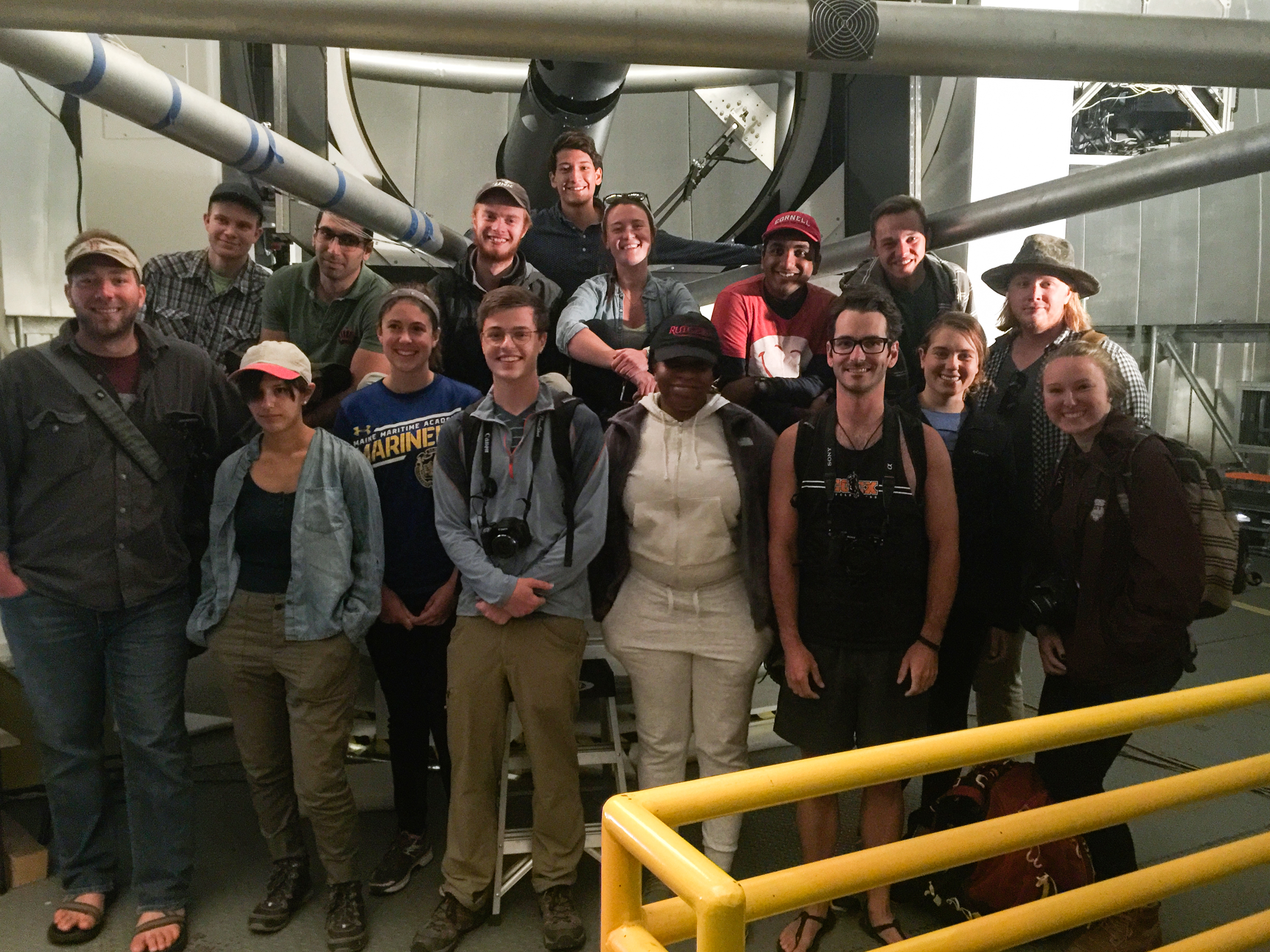
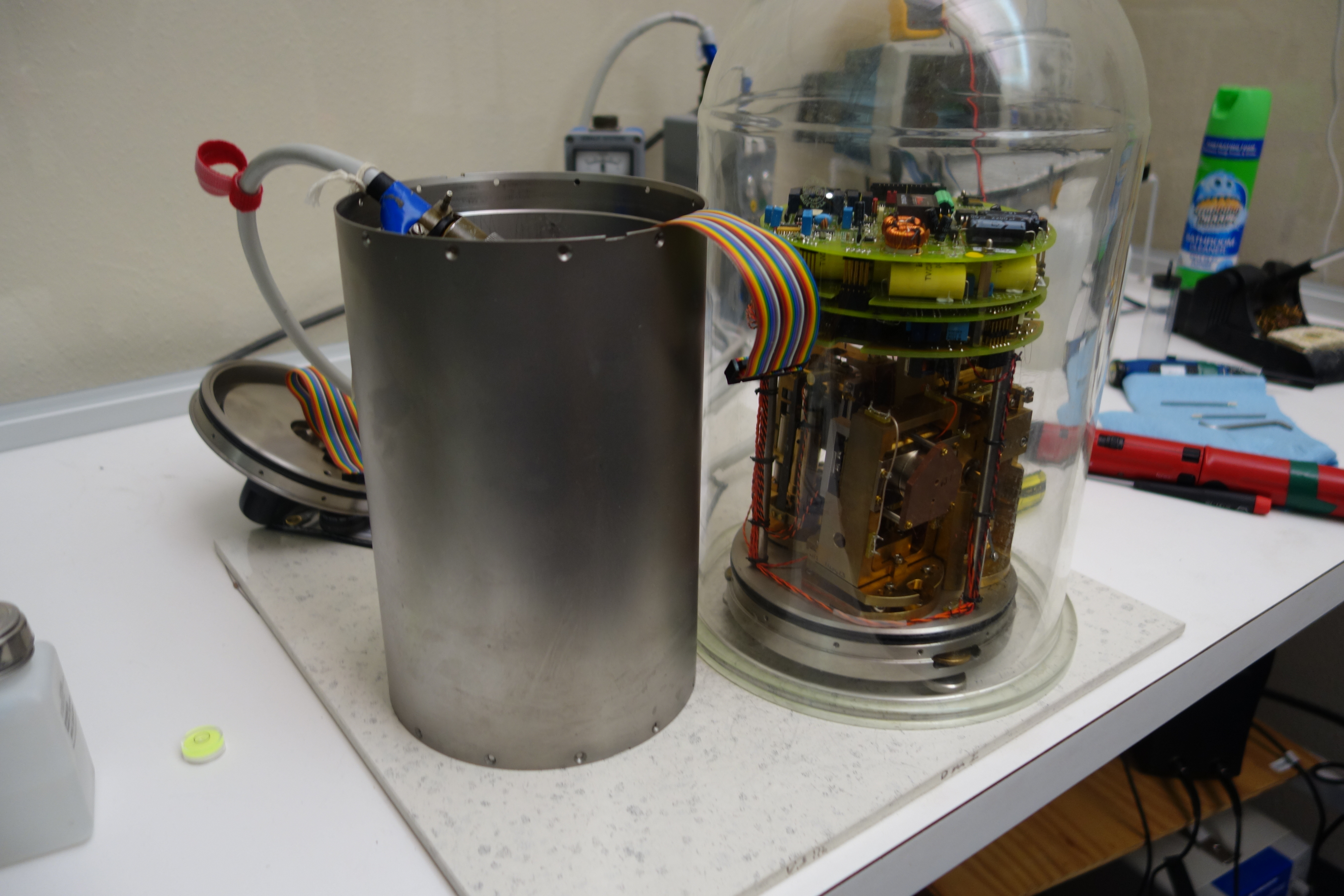
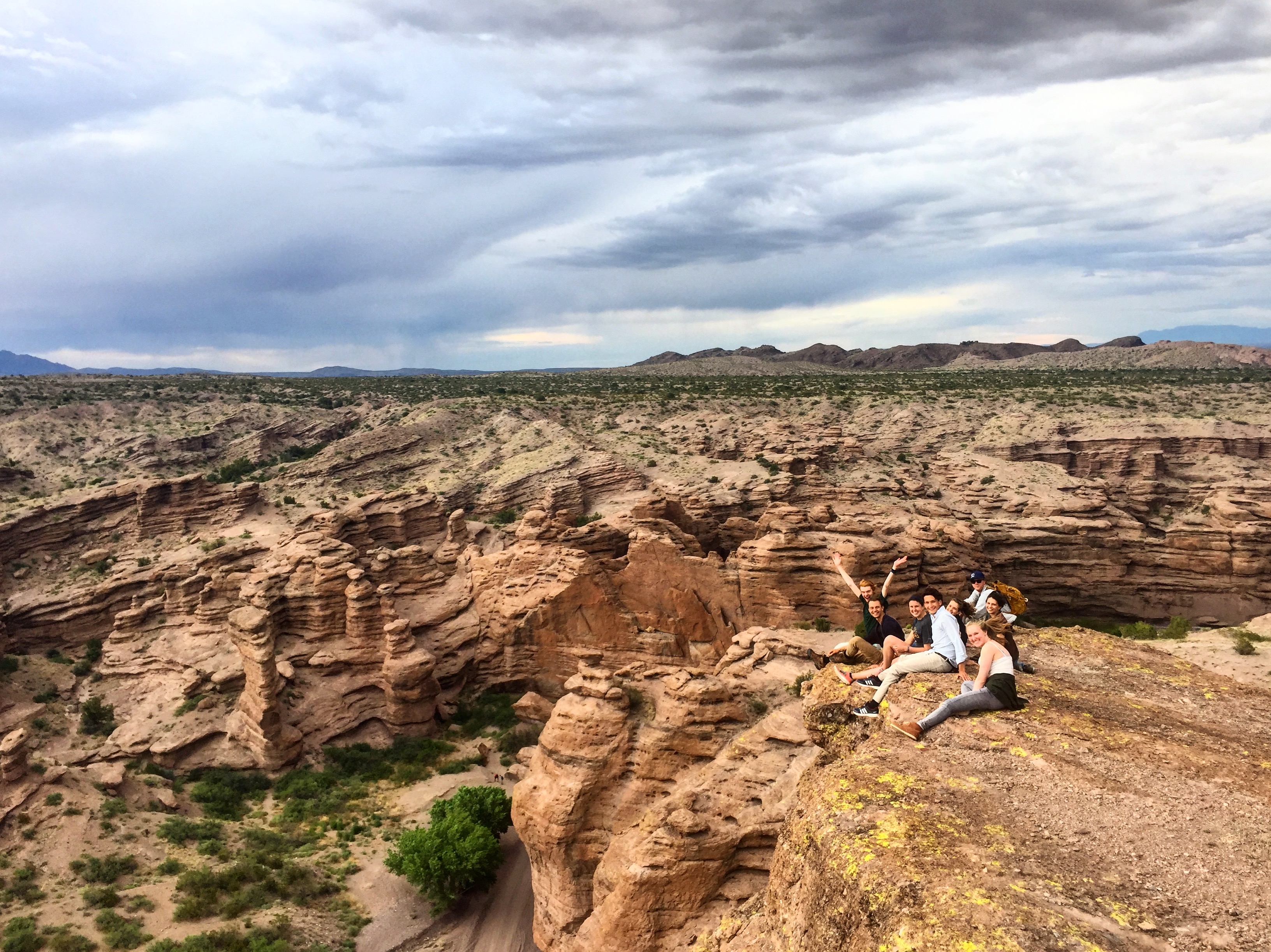
The group at the Magdalena Ridge Observatory, the guts of a seismometer, San Lorenzo Canyon, and Yours Truly producing some active source data (photo creds to Brady Flinchum for that one).
The next morning (Saturday, June 3rd) we all headed off for our assignments for the summer, and as such I'm sitting and writing this from Canberra, Australia where I'll start my project next week. It's lovely here, but more on that in a few days when I've explored more.



